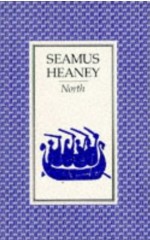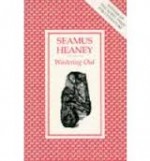Seamus Heaney and the Irish Language (Cuid a hAon as ‘N’Fheadar’) Posted by róislín on Sep 15, 2013 in Irish Language
(le Róislín)
Continuing a bit longer writing about the late and lamented Seamus Heaney, it occurred to me that it would be interesting and beneficial to learners to write on how he uses the Irish language, given that his medium is, basically, English. Sometimes Heaney uses an Irish word, in its original spelling, either as a title or embedded in the text of a poem. Depending on the particular poem, there may or may not be an actual translation of the Irish, but, as I recall, there usually is not. Two examples are “Aisling,” from his collection North (1975) and “Maighdean Mara” [sic] from Wintering Out (1972). In other poems, Heaney may use Irish words in their anglicized spellings (like “bullaun”) or may imply them but not state them outright. Further discussion of the latter will have to wait for another blog.
 In neither “Aisling” nor “Maighdean Mara” does Heaney offer any additional explanation of the titles within the text of the poem. The words would be presumed familiar to most early readers of his poetry, who were primarily in Ireland or very familiar with Irish literature and probably Irish folklore also. These two poems appear relatively early in his nearly 50-year publishing career (1966, Death of a Naturalist; 2010, Human Chain). But even in Ireland, most of the population was not Irish-speaking at the time (nor is it today). How would this first generation of Heaney readers have known these words, if they, too, were primarily English-speaking?
In neither “Aisling” nor “Maighdean Mara” does Heaney offer any additional explanation of the titles within the text of the poem. The words would be presumed familiar to most early readers of his poetry, who were primarily in Ireland or very familiar with Irish literature and probably Irish folklore also. These two poems appear relatively early in his nearly 50-year publishing career (1966, Death of a Naturalist; 2010, Human Chain). But even in Ireland, most of the population was not Irish-speaking at the time (nor is it today). How would this first generation of Heaney readers have known these words, if they, too, were primarily English-speaking?
For “Aisling” [ASH-ling] the word might have been readily recognized since it is a term for a genre of poetry and is also used as a girl’s name. “Aisling” can mean “a vision,” “a dream,” or “a narrative poem based on a dream or vision,” usually with the sovereignty of Ireland as the underlying theme and usually from the 17th or 18th century.
Although the word “Aisling” can be translated, literary “aislingí” are generally referred to as just that, much as we don’t normally translate words like “cinquain,” “haiku,” or “ghazal” for other genres of poetry.
It’s hard to say now how widely recognized the word “aisling” would have been in 1975 among English speakers, or in the international readership of Heaney’s poetry. Currently, though, I note that a Google search for “aisling” yields ca. 5,680,000 hits, far more than most Irish words. Even the well-known “sláinte” only gets a paltry 1,720,000 and “craic” yields 4,160,000. Of course, as with all Google searches, I’m sure that the number of hits would be reduced as one plowed (OK, ploughed, if you prefer) through the list, but we’re still dealing with a very large number!
Some of these hits are due to Heaney’s poem itself and may simply be passing references. Others are due to the following high-profile usages:
1) the ship named LÉ Aisling, an offshore patrol vessel in the Irish Navy (http://en.wikipedia.org/wiki/L%C3%89_Aisling_(P23))
2) the character “Aisling” in the recent delightful animated movie, The Secret of Kells (http://www.imdb.com/title/tt0485601/ or http://www.secretofkellsstore.com/)
3) Aisling Capital, a private equity fund investing in life science companies, based in New York, which came in third in my Google search, preceded only by the Wikipedia entries for “Aisling” as a name and “Aisling” as a literary form, proving once again that “Money talks!’, and,
4) Aisling Ghéar, an Irish-language theater company based in Belfast (http://www.aislingghear.com/).
But however the hits are divided up, the basic fact remains that “Aisling” is a widely used and widely recognized word, even outside Irish-speaking circles.
Next we’ll look at “Maighdean Mara” [MAI-djun MAH-ruh, with the “mai” like English “eye” or “pie,” not like “rain” or “train”], lit. “maiden of the sea.” This is sometimes translated as “mermaid,” but doesn’t always mean “mermaid” in the strict sense of the word. For example, in the folk song, “An Mhaighdean Mhara” (as sung by the Donegal bands Altan and Clannad, among others) the term could also refer to selkie women (seals who became women when they removed their seal skin– a saga unto itself–and sometimes married mortal men and bore human children but always hoped to return to the sea). Heaney’s poem doesn’t specifically refer to the Donegal song, but both tell essentially the same story, that of the seal-wife. In Heaney’s poem, dedicated to “Seán Oh-Eocha” [sic], the traditional story of the sea-maiden becomes a metaphor for a modern-day young woman’s suicide by drowning. “Seán Oh-Eocha,” by the way, would be “Seán Ó hEochaidh (1913-2002), an Irish folklorist from Teelin, Co. Donegal (not Seán Haughey, the politician, b. 1961, whose surname in Irish would also be “Ó hEochaidh,” who, after all, would only have been about 10 years old when the poem was written–although poems can, of course, sometimes be dedicated to children).
“Maighdean” literally means “maiden” or “virgin” and “mara” means “of the sea,” from the word “muir” (sea). I would normally expect the phrase for “sea-maiden” to be “maighdean mhara,” but when I compare Google hits for the two forms of the word, the results are closer than I thought they would be:
maighdean mara: 10,400 (many referring, of course, to Heaney’s poem, and many more referring to a specific boat available for day trips in Galway)
maighdean mhara: 9,220 (many referring to the Altan or Clannad versions of the song)
Although my copy of Wintering Out, part of the Poems 1965-1975 anthology, has no explanatory notes or acknowledgments, the original (1972) edition apparently did. Or let me rephrase that–it had one explanatory/glossary note. At the bottom of a page of recognition to various editors and journals where the poems had previously appeared, Heaney tucked in this little comment, at the bottom of the page, “Maighdean Mara” is the Irish for “mermaid.” This placement is curious because I don’t think most people thoroughly read an “acknowledgments” page, unless they’re seeking to reprint a selection. It’s also interesting that the acknowledgments and the “note” are not included in the 1975 edition by Farrar, Straus, and Giroux, even though it doesn’t really take up much space. It’s mostly significant, though, that the note about “Maighdean Mara” wasn’t readily accessible in the normal place where one would look for such information, a glossary in the “end matter” or a footnote in small print on the page where the poem is printed.
And what about the early readers of Heaney’s poetry who didn’t recognize these words? Well, they might have turned to an Irish-English dictionary, where they would have been found readily enough. Not that Irish-English dictionaries were two a penny in the early 1970s. Ó Dónaill’s didn’t appear until 1977 and the first Foclóir Póca appeared in 1986. Of course, there were earlier publications, but most would have involved reading the “sean-chló” (old print, discontinued ca. 1960), which would have discouraged some people from looking further.
Remember, also, that 1972 and 1975 were pre-Internet, for most people, and so you couldn’t have just “Googled” the term. Neither Google, the company, nor “to Google,” as a verb, existed yet. So what did these Irish words mean to the first generation of Heaney readers? We may never know. If nothing else, the Irish words might simply have added to the intrigue of the poetry. Some of my earliest memories of the joy of reading include finding “foreign” or even “dialect” words embedded in an English text. As I recall, these ranged from “Darzee” (the tailor-bird from Kipling’s “Rikki-Tikki-Tavi”), to “Hen Wen,” in Lloyd Alexander’s Chronicles of Prydain. And on the dialect side, Burnett’s The Secret Garden prepared me seamlessly for the “wuthering” of Wuthering Heights (“Listen to th’ wind wutherin’ round the house” — Martha Sowerby to Mary Lennox).
This blog is just a brief sample of Heaney’s use of Irish. With at least 30 major works (poetry anthologies, prose collections, dramas, and translations) and about 600 poems to his credit, there are many more such examples. And sometimes he is inspired by Irish words, or alludes to them, but doesn’t actually include them in the text. Of course, he is equally adept at juggling ancient Greek, Old English, Old Norse and other languages in the tapestry of words which is his legacy. An Béarla, ar ndóigh, an dlúth, agus An Ghaeilge agus na teangacha eile an t-inneach.
Hope you found this both suimiúil and úsáideach – Róislín
Mionghluais (since the rest of the Irish is explained within the blog)
dlúth [dloo], warp (in the weaving of fabric); inneach [IN-yukh], weft or woof (in the weaving of fabric); n’fheadar [NYA-dur], I don’t know (sometimes “I wonder”); suimiúil, interesting; úsáideach, useful
e-bibliographical notes: The full e-book version of North is available online (http://books.google.com); the poem “Aisling” is currently available in the free preview.
So far, I haven’t found a full version of “Maighdean Mara” available online, which isn’t surprising, since, like all Heaney’s works, it is under copyright. Wintering Out is also available as an e-book (http://books.google.com). Portions are also available for free. While it’s useful to have some of the e-book version available online for free, I was struck by the fact that Seán Ó hEochaidh’s name is further transmogrified in this 2011 edition, becoming “Seén Oh-Eocha” [sic!]. Probably one of those accent mark issues, where WYSI-not-WYG, going from the original to the electronic versions. Speaks for itself, I guess. It’s a good online resource though, reproducing some of the poems in full, but not, sadly, “Maighdean Mara,” at least not when I checked it
Naisc do bhlagmhíreanna faoi Heaney sa tsraith seo, an bhlagmhír seo ina measc :
Séamus Ó hÉanaí / Seamus Heaney (1939-2013)Posted by róislín on Sep 6, 2013 in Irish Language
Ag Caint faoi Heaney, a shaol agus a bhás (i nGaeilge) agus gluaisPosted by róislín on Sep 11, 2013 in Irish Language
Seamus Heaney and the Irish Language (Cuid a hAon as ‘N’Fheadar’)Posted by róislín on Sep 15, 2013 in Irish Language
Seamus Heaney and the Irish Language (Cuid a Dó as Trí)Posted by róislín on Sep 19, 2013 in Irish Language
Seamus Heaney and the Irish Language (Cuid a Trí as Trí) Posted by róislín on Sep 22, 2013 in Irish Language

Build vocabulary, practice pronunciation, and more with Transparent Language Online. Available anytime, anywhere, on any device.





Leave a comment: